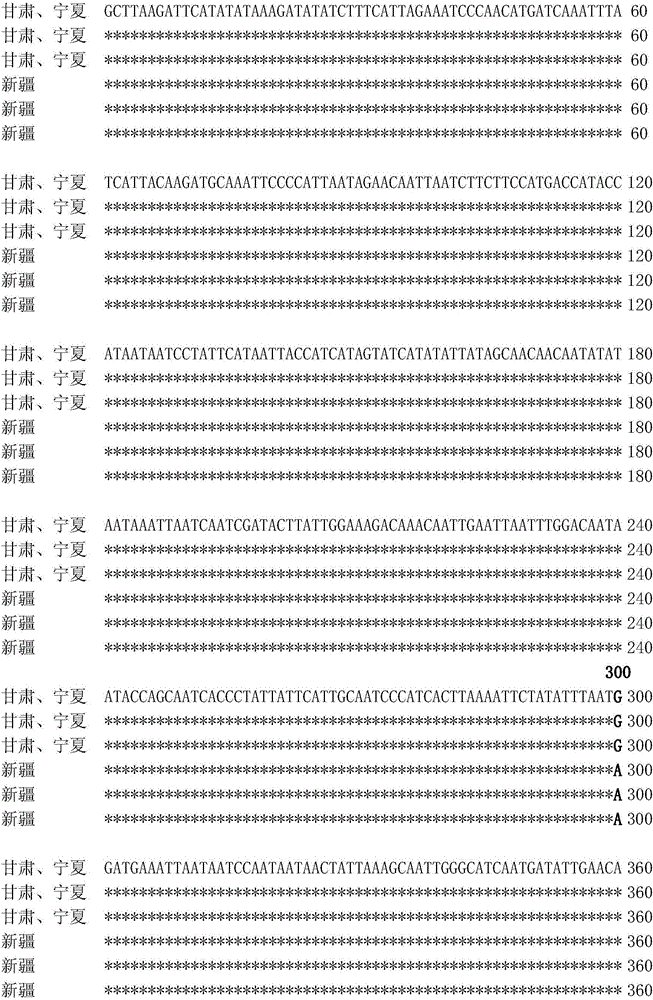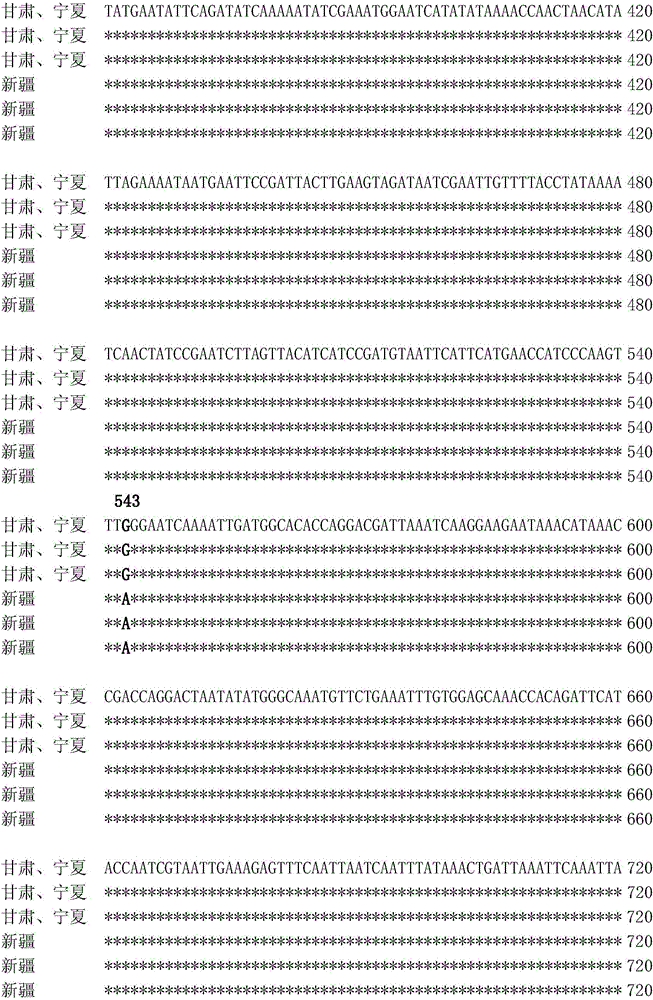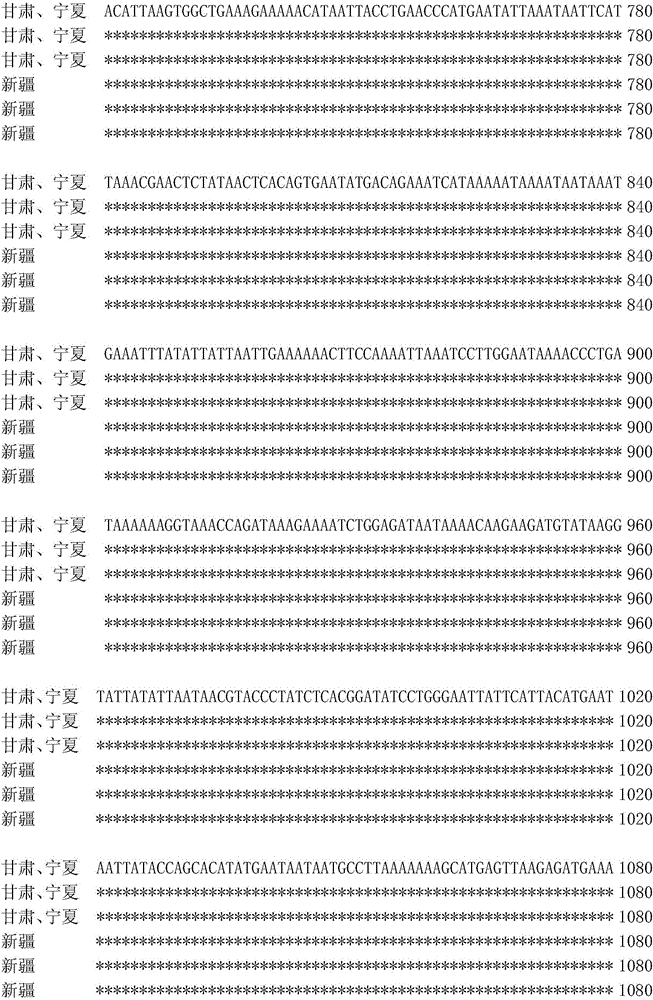Method for identifying Lygus pratensis populations by mitochondrial molecular markers
A technology of forage grass bug and molecular marker, applied in the field of molecular biology, can solve the problems of difficulty in distinguishing, inconspicuous differences in external morphological characteristics of insects, difficult identification, etc., and achieves strong repeatability, simple and reliable molecular identification method, Actionable effect
- Summary
- Abstract
- Description
- Claims
- Application Information
AI Technical Summary
Problems solved by technology
Method used
Image
Examples
Embodiment 1
[0032] Example 1 Design and Synthesis of PCR Primer Combinations for Identifying Lygus Grass Populations
[0033] According to the mitochondrial cytochrome oxidase II (COII) gene, cytochrome b (Cytb) gene, mitochondrial NADH dehydrogenase subunit 5 (ND5) gene and 16SrDNA sequence of Lygus grazing bug, the PrimerPrimer5 software was used to design PCR amplification of the above-mentioned Specific primers for the four genes. The primer sequences are as follows (SEQ ID NO: 1-8):
[0034] ①L-COII-F: 5'–TGGCAGAATAAGTGCCATGA–3'
[0035] L-COII-R: 5'–GAGACCAATGCTTTTCTTTCAGC–3'
[0036] ②L-ND5-F: 5'–AAACATAATTACCTGAACCCATGAA–3'
[0037] L-ND5-R: 5'–TCTTCAACTTTAGTAACTGCAGGAG–3'
[0038] ③L-Cytb-F: 5'–TCTAATTGATCTTCCTAGCCCAAG–3'
[0039] L-Cytb-R: 5'–CCGTGCTCCAATTCATGTTA–3'
[0040] ④L-16S-F: 5'–TCCACAAATATCCCCAATCTG–3'
[0041] L-16S-R: 5'–CCTTGAAATGTCCCTTCTCG–3'
[0042] The above primers were synthesized by Shanghai Bioengineering Technology Service Co., Ltd.
Embodiment 2
[0043] Example 2 Using mitochondrial molecular markers to quickly identify the method of Lygus genus Xinjiang population and Gansu Ningxia population
[0044] 1. Collect individuals of Lygus forages in Xinjiang, Gansu and Ningxia, and extract whole genome DNA
[0045] Representative populations were selected in Xinjiang, Gansu and Ningxia of China, that is, Kuqa, Korla and Shache in Xinjiang, Wuwei in Gansu, and Qingtongxia in Ningxia collected Lygus individuals. The field collection of Lygus grass bugs adopts the net catch method, and the adults are collected by sucking tubes, and then the adults are put into absolute ethanol, and then brought back to the laboratory, and the morphological characteristics of the adults are further identified and confirmed by a body dissecting microscope to ensure the species identification correct.
[0046] When extracting genomic DNA, the abdomen and wings of adults were removed, and the remaining tissue structures were used as test material...
Embodiment 3
[0058] Example 3 Analysis of Specificity and Sensitivity of Using PCR Primers L-Cytb-F / L-Cytb-R to Detect Lygus Grass
[0059] 1. Sample source:
[0060] Two kinds of Lygus lygus are used in the present embodiment, wherein Lygus lygus is from Korla, Gansu, Qingtongxia, Ningxia; Kuqa and Shache areas, these samples are preserved in the Plant Protection Laboratory of the Cotton Research Institute of the Chinese Academy of Agricultural Sciences.
[0061] 2. DNA extraction:
[0062] Described with embodiment 2.
[0063] 3. PCR amplification:
[0064] The PCR reaction system and PCR amplification procedure are the same as those described in Example 2.
[0065] 4. Result analysis:
[0066] Take 5 μL of the PCR amplification product, electrophoresis on 2% agarose gel, the voltage is 150V, and the result is detected under ultraviolet light after 25 to 30 minutes. If a characteristic band with a size of about 910bp appears, it proves that the detected sample is Grass bugs. The r...
PUM
 Login to View More
Login to View More Abstract
Description
Claims
Application Information
 Login to View More
Login to View More - R&D
- Intellectual Property
- Life Sciences
- Materials
- Tech Scout
- Unparalleled Data Quality
- Higher Quality Content
- 60% Fewer Hallucinations
Browse by: Latest US Patents, China's latest patents, Technical Efficacy Thesaurus, Application Domain, Technology Topic, Popular Technical Reports.
© 2025 PatSnap. All rights reserved.Legal|Privacy policy|Modern Slavery Act Transparency Statement|Sitemap|About US| Contact US: help@patsnap.com



